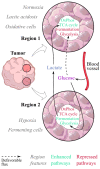How Warburg-Associated Lactic Acidosis Rewires Cancer Cell Energy Metabolism to Resist Glucose Deprivation
- PMID: 36900208
- PMCID: PMC10000466
- DOI: 10.3390/cancers15051417
How Warburg-Associated Lactic Acidosis Rewires Cancer Cell Energy Metabolism to Resist Glucose Deprivation
Abstract
Lactic acidosis, a hallmark of solid tumour microenvironment, originates from lactate hyperproduction and its co-secretion with protons by cancer cells displaying the Warburg effect. Long considered a side effect of cancer metabolism, lactic acidosis is now known to play a major role in tumour physiology, aggressiveness and treatment efficiency. Growing evidence shows that it promotes cancer cell resistance to glucose deprivation, a common feature of tumours. Here we review the current understanding of how extracellular lactate and acidosis, acting as a combination of enzymatic inhibitors, signal, and nutrient, switch cancer cell metabolism from the Warburg effect to an oxidative metabolic phenotype, which allows cancer cells to withstand glucose deprivation, and makes lactic acidosis a promising anticancer target. We also discuss how the evidence about lactic acidosis' effect could be integrated in the understanding of the whole-tumour metabolism and what perspectives it opens up for future research.
Keywords: Warburg effect; glucose deprivation; lactic acidosis; metabolic symbiosis; tumour heterogeneity.
Conflict of interest statement
The authors declare no conflict of interest.
Figures


References
-
- Warburg O. The Metabolism of Carcinoma Cells. J. Cancer Res. 1925;9:148–163. doi: 10.1158/jcr.1925.148. - DOI
Publication types
Grants and funding
LinkOut - more resources
Full Text Sources

